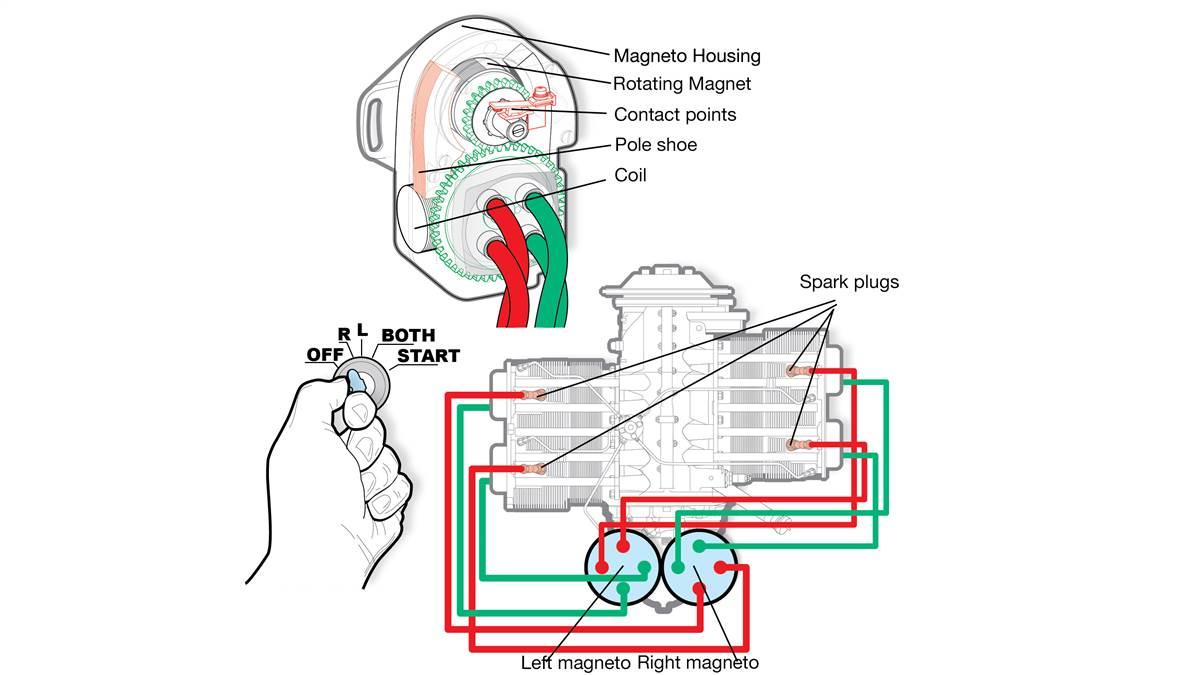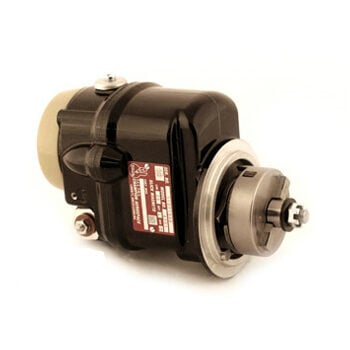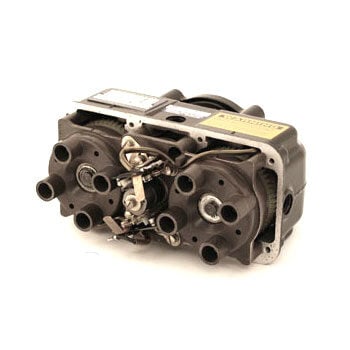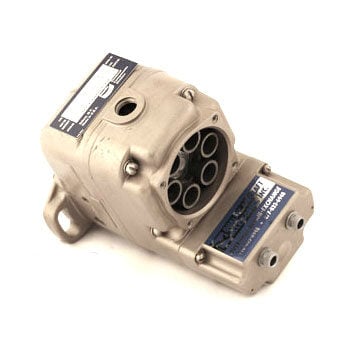What Are Aircraft Magnetos and How Do They Work?
A magneto is a self-contained electrical generator that uses magnets to produce a high-voltage current that fires the engine spark plugs. Spark plugs ignite the fuel/air mixture and combustion takes place. If there’s no energy, there’s no combustion!
An aircraft magneto is comprised of a rotating magnet in close proximity to a high-output coil. As the magnet spins, it generates electricity until it achieves a spike of 20,000 to 30,000 volts. When this voltage spike is achieved, a distributor carries the amplified current to the spark plug, which ignites the fuel-air mixture to fire the pistons.
Two magnetos are needed to operate as the heart of a piston engine system. Because of their simple design, magnetos are compact, and because they require no external electrical source to operate, they are reliable.
Regular Magneto maintenance is recommended by all magneto manufacturers whether it’s Slick, Bendix or PowerUp. 500 hours between maintenance intervals is a good rule of thumb. Some manufacturers have a time-in-service allowance. Check the component maintenance manual for your magneto for more specific details.

Illustration by Steve Karp

Ignition Redundancy
Aircraft piston engines are designed with two independent ignition systems—that is to say, two spark plugs per cylinder. Likewise, there are two magnetos, left and right. The left aircraft magneto fires one plug per cylinder, while the right aircraft magneto fires the other. This redundant system ensures that the ignition will keep sparking even if one magneto fails.
Types of Aircraft Magnetos
There are various types and brands of aircraft magnetos and choosing the right one for your aircraft application is important. The predominant aircraft magneto types are Slick Magnetos, Bendix dual magnetos, and Bendix single magnetos.

Slick Magnetos
Currently these magnetos are manufactured by Champion Aerospace. The Slick Magneto line was acquired by Champion in 1990s. Slick Magnetos offer a smaller and lighter design compared to other aircraft magnetos. The light weight of the part allows for easier installation of a Slick Magneto. The noise suppression of the magneto is also a feature that allows for the elimination of magneto filters on Slick Magnetos.
Parts for Slick magnetos are engineered for balanced wear which allows for predictable wear on the part and time for servicing. Another benefit of Slick Magnetos is the ease to keep up maintenance due to new parts used for servicing. All repair work for a Slick Magneto is to be completed in compliance with Champion manual L1363.

Bendix Dual Magnetos
A dual magneto is an arrangement in which the left aircraft magneto and right aircraft magneto are contained in a single housing and operated by a single magnet rotor and engine drive.
Due to both magnetos being together there is significant reduction in weight and space taken up by a dual magneto as compared to single magnetos. Moreover, the single-housing design allows for more regular maintenance of the ignition system.
Dual magnetos were produced by Teledyne Continental Motors until October of 2010, when the line was ended. There are two series of dual magnetos available, D2000 and D3000, which differ mainly in the design of the housing.

Bendix Single Magnetos
A Bendix single magneto, commonly referred to as a “Bendix Mag”, is a specific type of aircraft magneto manufactured by Teledyne Continental Motors. Bendix single magnetos have been in continuous production by TCM since 1947. They are known for their light weight, compact design, reliability, and high output. There are multiple models of Bendix magnetos for different types of aircraft applications.
The S-20 series Bendix magneto can be impulse coupled or direct drive. This series will have a feed through capacitor that filters out radio noise from the magneto. The “short cover” Bendix magneto, which is easily distinguished by the rear contact cover, is a variation of this series. The S-200 series Bendix magneto uses an ignition vibrator along with a retard breaker assembly to start the engine. The last series is the S-1200. These Bendix magnetos can be impulse coupled or use retard breaker contact assembly. This Bendix Magneto series is able to reach higher voltages to allow for higher altitude of flight.
FAQs for Aircraft Magnetos & Aircraft Magneto Overhaul
Having trouble with your aircraft magneto?
- Why do aircraft need magnetos?
-
In aircraft engines, it is important to maintain an ignition system independent of the electrical system, so that the engine will continue to run in the event of alternator or battery malfunction. Additionally, aircraft magnetos provide a compact and reliable means for igniting the spark plugs.
- Is the Aircraft Magneto connected to the rest of the electrical system?
-
No, the aircraft magneto ignition system is self-contained and independent from the aircraft electrical system. In the event of an electrical failure, the mechanical aircraft magneto will continue to provide spark to the engine.
- What are Magnetos?
-
Magnetos are self-contained, high-voltage generators that provide ignition to aircraft engines through spark plugs. The over 100-year-old technology can also be found in power tools and landscaping equipment like lawn mowers, chainsaws and older tractor models. As ignition systems for piston aircraft engines, they are particularly beneficial due to their self-contained nature: because they are completely separate from the battery and electrical system, magnetos keep the engine running even if these systems fail.
- Why are there two Aircraft Magnetos?
-
The dual arrangement of aircraft magnetos produces a smoother and more complete combustion of the fuel mixture. It also provides for ignition redundancy, so that the engine will continue to run in the event that one magneto malfunctions.
- If one Aircraft Magneto fails do I have to service both magnetos?
-
It is not required to service both aircraft magnetos at the same time but it is a good idea to keep the pair of magnetos on the same maintenance schedule to avoid additional down time in the future.
- What is the difference between a Pressurized and Non-Pressurized Aircraft Magneto?
-
Pressurized aircraft magnetos are usually found in turbocharged engines. Air is diverted from the turbocharging system and sent through a line to a fitting installed in the aircraft magneto. The aircraft magneto is also fitted with an opening at the bottom of the housing to allow a small air leak. This opening insures a constant flow of air through the aircraft magneto to avoid the internal air from becoming ionized.
- How do I Install an Aircraft Magneto?
-
Aircraft magneto installation is a straightforward but delicate process. Improper installation can lead to damage of the magneto. Installation should be handled according to the manufacturer’s specifications and procedures, though experienced mechanics may find these tips helpful.
- How Do I Time an Aircraft Magneto?
-
Simple changes to your aircraft magnetos’ timing can improve ignition efficiency and optimize fuel use. Click here for a useful overview.
- How Do I Factory Overhaul an Aircraft Magneto?
-
Because of their simple and reliable design, aircraft magnetos can often be overhauled or factory overhauled, rather than replaced. Aircraft magneto overhaul simply involves disassembling the magneto and replacing parts as necessary, whereas a magneto must be brought to factory-new standards as determined by the manufacturer in order to be considered factory overhauled. Both operations should be done according to the manufacturer’s specifications. (See our guide here for more information about aircraft magneto overhauling versus factory overhauling Slick magnetos.)
- How Do I Test an Aircraft Magneto?
-
It is especially important, when checking your magnetos, to know just what you’re looking for. A useful breakdown of the routine magneto test can be found here.
- What powers the magnetos on an airplane?
-
Magnetos operate through electromagnetic induction: a permanent magnet (or magneto) generates a magnetic field by spinning in close proximity to a coil of wire. Fluctuations in the magnetic field establish an electrical current that travels to the spark plugs and ignites the fuel/air mixture to fire the engine.
- How many magnetos are on an aircraft engine?
-
There are typically two magnetos on an aircraft, a left and a right (for this reason, they are usually sold in pairs, or as a dual magneto). The design contributes to a more even combustion, and also provides redundancy: if one of your magnetos fails, the second acts as a backup to keep the engine running.
- What does a magneto do in an airplane?
-
Simply put, magnetos provide ignition to aircraft engines. They work by generating a high-voltage electrical current from a magnetic field, which fires the spark plugs and ignites the fuel mixture in a cylinder.
- What causes a magneto to fail?
-
A magneto can stay in good shape for years, but ultimately, it will start to lose its magnetic strength. At this point, the electric current it produces will become weaker and less effective at starting the engine. For this reason, it is important to have magnetos inspected, and replaced if needed, at every 500 hours of service. It’s also recommended to conduct regular in-flight magneto checks to identify potential issues before they become serious.
- How to fix a magneto:
-
First, make sure to have your magnetos inspected at 500 hours of service to prevent major problems. If and when you need your magnetos serviced, you can likely have them overhauled instead of replacing them. This simply means that they can be disassembled, with specific parts replaced as needed. In the case of a factory overhaul, the magneto will be overhauled to meet “factory-new” standards.
- Magneto troubleshooting
-
Still having trouble with your magnetos? Browse our Ultimate Magneto Troubleshooting Guide to diagnose the problem. Your aircraft will be up and running in no time!
Glossary of Aircraft Magneto Parts
Aircraft Ignition Harness: Shield the high voltage and conducts it to the spark plugs, often bound together. The wires are screened or in a metal braid or conduit to shield the radio against the high frequency ignition interference.
Aircraft Magneto: Part of ignition system on most reciprocating aircraft engines. This part is a self-contained unit which is driven by the engine and produces the electrical current for the engine with no outside source of current.
Bendix Magneto: Part of ignition system on most reciprocating aircraft engines. This part is a self-contained unit which is driven by the engine and produces the electrical current for the engine with no outside source of current.
Cam Impulse Spring: Spring inside of the impulse that builds tension as the impulse coupling rotates until the magneto is ready to fire.
Cam Lobe: a rotating or sliding piece in a mechanical linkage used especially in transforming rotary motion into linear motion or vice versa.
Capacitor (Condenser): The component in an airplane magneto that is used to store electrical energy temporarily in an electrical field. It is a passive two-terminal electrical component.
Coil: The part in the aircraft magneto that creates high voltage current necessary to fire a spark plug. The part is made of a soft iron core with two windings of wire around it.
Distributor Gear Assembly: Takes the high-voltage electric current from the coil and distributes it to the four electrodes in the distributor block.
Dual Magneto: An airplane magneto which contains one drive source to power both magnetos and therefore firing all sparkplugs and cylinders for the engine.
Ferrule: Combines with the special electrical properties of the coiled conductor for a ground shield and to reduce radio interference. Mechanically secures the wire to the harness cap. This part is found in the terminated ends of aircraft ignition harness leads.
Frame (Housing): The magneto frame is the aluminum alloy shell that houses most of the Bendix Magneto components.
Harness Nut: A small metal collar, usually having a hexagonal shape. The nut is used to secure the ignition wire to the spark plug for the aircraft ignition harness.
Ignition Wire: Copper-coated, stainless steel coiled conductor encased in silicone and fiberglass and sheathed by a woven metallic braid impregnated with silicone. The wire in an aircraft ignition harness that carry the charge from the aircraft magneto the cylinder for ignition.
Impulse Coupling Assembly: Enables the magneto to produce sufficient spark for starting the engine. Normally mounted on the left Bendix Magneto only, consists of a main body, cam plate, large coiled spring, and flyweights which pivot on pegs welded to the cam plate.
Magneto: an electric generator that creates periodic pulse of alternating current by using permanent magnets
Overhaul: A part that is disassembled and examined, parts are replaced as necessary according to the manufacturer’s overhaul manual.
Points (Contact Breaker): an electrical switch which is used to interrupt the current flowing in the primary circuit. It is found in the distributor side of aircraft magnetos.
Pole Shoes: consist of thin, soft iron plates laminated together. They allow the transfer magnetic flux from the rotor to the iron core of the coil in aircraft magnetos.
Factory Overhaul: A condition description for a part that has been worked on to restore it to factory new conditions.
Rotor: Rotated in the aircraft magneto by the engine’s accessory drive via the impulse coupling. The central drum of the rotor is magnetized with north and south magnetic poles. The magnetic flux from the rotor is transferred by the pole shoes to the coil.
Single Magneto: An aircraft magneto that is half of the ignition system in one unit and will be paired with another airplane magneto. It fires half of the sparkplugs that go to all of the cylinders in the engines.
Slick Magneto: Part of ignition system on most reciprocating aircraft engines. This part is a self-contained unit which is driven by the engine and produces the electrical current for the engine with no outside source of current.
Swage: To press the individual leads of an aircraft ignition harness into a magneto cap.
Additional Resources
Champion Aerospace Slick Magnetos
https://www.championaerospace.com/products/slick-magnetos